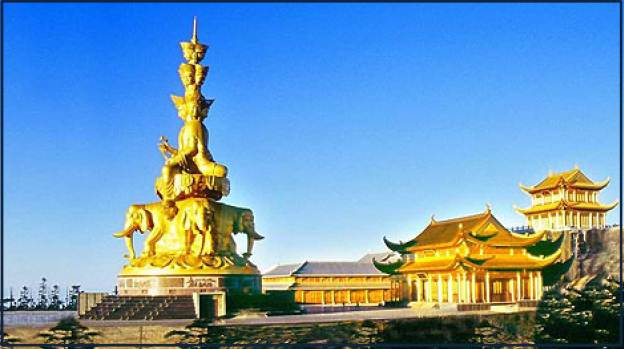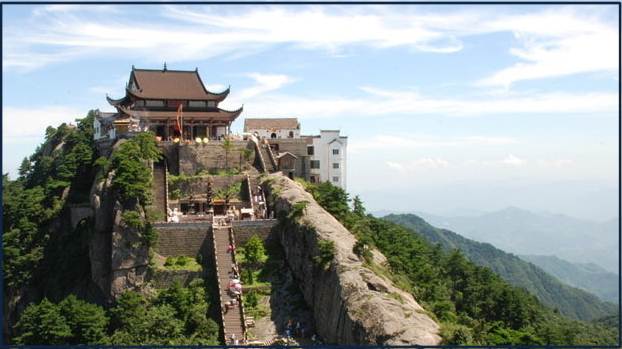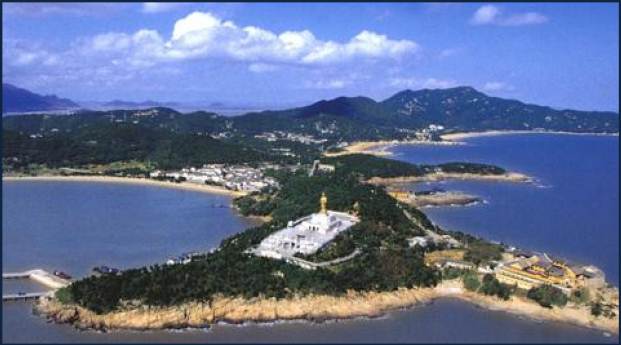Each of the four mountains is viewed as the abode or place of practice (dàocháng; 道場) of one of the four bodhisattvas.
Wu-tai Mountain (五台山,Wǔtái Shān, Five-Platform Mountain)
or Qing-Liang –Shan (清涼山, Clear Cool Mountain), Shanxi Province
 According to Avatamsaka Sutra (華嚴經), which describes the abodes of many bodhisattvas, Manjushri or Wenshu (文殊菩薩) is said to reside on a "clear cold mountain" in the northeast.
This served as charter for the mountain's identity and its alternate name "Clear Cool Mountain".
According to Avatamsaka Sutra (華嚴經), which describes the abodes of many bodhisattvas, Manjushri or Wenshu (文殊菩薩) is said to reside on a "clear cold mountain" in the northeast.
This served as charter for the mountain's identity and its alternate name "Clear Cool Mountain".
Wu-tai is surrounded by a cluster of flat-topped peaks (East东台望海峰,South南台锦绣峰,Central中台翠岩峰,West西台挂月峰, North北台叶斗峰).
The North peak, called Beitai Ding or Yedou Feng is the highest point (3.061 m) in northern China.
Nanshan Temple (南山寺) is established in the Yuan dynasty (1271–1368), the whole temple comprises seven terraces, divided into three parts (1) the lower three terraces Jile Temple(極樂寺),
(2) the middle terrace Shande Hall (善德堂), and
(3) the upper three terraces Youguo Temple (佑國寺). Other major temples include Xiantong Temple (显通寺) the largest temple in Wu-tai with a special complete bronze building,
Tayuan Temple (塔院寺) with the 56.4-meter height Great White Stupa, and Pusading Temple (菩薩顶) as the most complete Tibetan Buddhist monastery in Wu-tai.
Er-mei Mountain (峨嵋山, Éméi Shān, High and Lofty Mountain), Sìchuān Province
 Ever since the East (Dong) Han dynasty (25-220) Er-mei Mountain had been famous with many fairy stories and aspired by practitioners as a mystical land of Taoism.
It was believed that many fairies were living in the mountains helping people avoid disasters from wars and sickness. It was in the early Bei (North) Song dynasty
(~960), the emperor brought in and strongly supported the development of Buddhism in Er-mei and eventually established this mountain as the holy abodes of
Samantabhadra, Chinese as Puxian (普賢菩薩).
Ever since the East (Dong) Han dynasty (25-220) Er-mei Mountain had been famous with many fairy stories and aspired by practitioners as a mystical land of Taoism.
It was believed that many fairies were living in the mountains helping people avoid disasters from wars and sickness. It was in the early Bei (North) Song dynasty
(~960), the emperor brought in and strongly supported the development of Buddhism in Er-mei and eventually established this mountain as the holy abodes of
Samantabhadra, Chinese as Puxian (普賢菩薩).
The site has seventy-six Buddhist monasteries of the Ming and Qing period, most of them located near the mountain top.
The most famous attractions are: (1) Golden Summit (金頂, 3077m) four Er-mei wonders - sunrise, clouds, Buddha light, and holy lantern, (2) Bao-guo Temple (報國寺),
the gateway into Er-mei and the center for a variety of Buddhist activities, and (3) Qing-yin Pavilion (清音閣) a.k.a. Lying Cloud temple (臥雲寺)
is famous for a pair of bridges over two (white/black) streams.
Jiu-hua Mountain (九華山,Jiǔhuá Shān, Nine Glories Mountain), Ānhuī Province
 Mount Jiu-hua was called Mount Lingyang (陵阳山)in Han dynasty (206 BC–220 AD). It was renamed to Jiu-hua by a great poet Li Bai of Tang dynasty (618–907).
There are 99 peaks in the area, among them Shiwang Peak, Lotus Peak, and others. In 719, Kim Qiaoque (金喬覺), a Silla (新罗国)prince (today's Qingzhou city in South Korea)
came to Jiu-hua, practiced Buddhism for 75 years, and died at 99 years of age. After he passed away, people saw the phenomenon of his life and after-dead resembles
various auspicious Ksitigarbha (Di-zang, 地藏菩薩, Jizō) displays thus believed he was a reincarnation of the bodhisattva.
As this result, Jiu-hua Mountain became the holy abode for Di-zang Boddhisatva. During the golden periods of the Ming and Qing dynasties,
there were as many as 360 temples and 4,000 to 5,000 monks and nuns.
Mount Jiu-hua was called Mount Lingyang (陵阳山)in Han dynasty (206 BC–220 AD). It was renamed to Jiu-hua by a great poet Li Bai of Tang dynasty (618–907).
There are 99 peaks in the area, among them Shiwang Peak, Lotus Peak, and others. In 719, Kim Qiaoque (金喬覺), a Silla (新罗国)prince (today's Qingzhou city in South Korea)
came to Jiu-hua, practiced Buddhism for 75 years, and died at 99 years of age. After he passed away, people saw the phenomenon of his life and after-dead resembles
various auspicious Ksitigarbha (Di-zang, 地藏菩薩, Jizō) displays thus believed he was a reincarnation of the bodhisattva.
As this result, Jiu-hua Mountain became the holy abode for Di-zang Boddhisatva. During the golden periods of the Ming and Qing dynasties,
there were as many as 360 temples and 4,000 to 5,000 monks and nuns.
Putuo Mountain (普陀山, Pǔtuó Shān, Mount Potalaka), Zhèjiāng Province
 Putuo Mountain is an island southeast of Shanghai. During the Tang dynasty(618–907), along with the development of sea silk road,
Putuo Mountain became the center of Chinese Buddhism because it was considered the bodhimanda (place of enlightenment) of Avalokitesvara (Guan-yin, 觀世音菩薩).
Since then, Putuo has been a pilgrimage site for over a thousand years. Every year on February 19 (birth), June 19 (being a monk), and September 19
(being bodhisattva) of the lunar calendar, millions of people come to celebrate.
Putuo Mountain is an island southeast of Shanghai. During the Tang dynasty(618–907), along with the development of sea silk road,
Putuo Mountain became the center of Chinese Buddhism because it was considered the bodhimanda (place of enlightenment) of Avalokitesvara (Guan-yin, 觀世音菩薩).
Since then, Putuo has been a pilgrimage site for over a thousand years. Every year on February 19 (birth), June 19 (being a monk), and September 19
(being bodhisattva) of the lunar calendar, millions of people come to celebrate.
The main attractions are: (1) Puji Temple (Universal Salvation, 普濟禪寺, 1334)
a.k.a. the Front-Temple(前寺) is the chief temple of Putuo, (2) Fayu Temple (Dharma Rain Temple,法雨禪寺, 1580) a.k.a. the Back-Temple(後寺) is second largest temple
in Putuo, (3). Hui-ji Temple (慧濟寺) was founded in the Ming dynasty and extensively renovated in 1907.
Other Buddhist Holy Sites in China
Yungang Grottoes (雲崗石窟)
Yungang Grottoes, ancient Chinese Buddhist temple grottoes near the city of Datong in the province of Shanxi,
is composed of 252 grottoes with more than 51,000 Buddha statues and statuettes.
Longmen Grottoes (龍門石窟)
Longmen Grottoes is in Hénán province. There are as many as 100,000 statues within the 1,400 grottoes.
|

 According to Avatamsaka Sutra (華嚴經), which describes the abodes of many bodhisattvas, Manjushri or Wenshu (文殊菩薩) is said to reside on a "clear cold mountain" in the northeast.
This served as charter for the mountain's identity and its alternate name "Clear Cool Mountain".
According to Avatamsaka Sutra (華嚴經), which describes the abodes of many bodhisattvas, Manjushri or Wenshu (文殊菩薩) is said to reside on a "clear cold mountain" in the northeast.
This served as charter for the mountain's identity and its alternate name "Clear Cool Mountain".  Ever since the East (Dong) Han dynasty (25-220) Er-mei Mountain had been famous with many fairy stories and aspired by practitioners as a mystical land of Taoism.
It was believed that many fairies were living in the mountains helping people avoid disasters from wars and sickness. It was in the early Bei (North) Song dynasty
(~960), the emperor brought in and strongly supported the development of Buddhism in Er-mei and eventually established this mountain as the holy abodes of
Samantabhadra, Chinese as Puxian (普賢菩薩).
Ever since the East (Dong) Han dynasty (25-220) Er-mei Mountain had been famous with many fairy stories and aspired by practitioners as a mystical land of Taoism.
It was believed that many fairies were living in the mountains helping people avoid disasters from wars and sickness. It was in the early Bei (North) Song dynasty
(~960), the emperor brought in and strongly supported the development of Buddhism in Er-mei and eventually established this mountain as the holy abodes of
Samantabhadra, Chinese as Puxian (普賢菩薩).  Mount Jiu-hua was called Mount Lingyang (陵阳山)in Han dynasty (206 BC–220 AD). It was renamed to Jiu-hua by a great poet Li Bai of Tang dynasty (618–907).
There are 99 peaks in the area, among them Shiwang Peak, Lotus Peak, and others. In 719, Kim Qiaoque (金喬覺), a Silla (新罗国)prince (today's Qingzhou city in South Korea)
came to Jiu-hua, practiced Buddhism for 75 years, and died at 99 years of age. After he passed away, people saw the phenomenon of his life and after-dead resembles
various auspicious Ksitigarbha (Di-zang, 地藏菩薩, Jizō) displays thus believed he was a reincarnation of the bodhisattva.
As this result, Jiu-hua Mountain became the holy abode for Di-zang Boddhisatva. During the golden periods of the Ming and Qing dynasties,
there were as many as 360 temples and 4,000 to 5,000 monks and nuns.
Mount Jiu-hua was called Mount Lingyang (陵阳山)in Han dynasty (206 BC–220 AD). It was renamed to Jiu-hua by a great poet Li Bai of Tang dynasty (618–907).
There are 99 peaks in the area, among them Shiwang Peak, Lotus Peak, and others. In 719, Kim Qiaoque (金喬覺), a Silla (新罗国)prince (today's Qingzhou city in South Korea)
came to Jiu-hua, practiced Buddhism for 75 years, and died at 99 years of age. After he passed away, people saw the phenomenon of his life and after-dead resembles
various auspicious Ksitigarbha (Di-zang, 地藏菩薩, Jizō) displays thus believed he was a reincarnation of the bodhisattva.
As this result, Jiu-hua Mountain became the holy abode for Di-zang Boddhisatva. During the golden periods of the Ming and Qing dynasties,
there were as many as 360 temples and 4,000 to 5,000 monks and nuns.
 Putuo Mountain is an island southeast of Shanghai. During the Tang dynasty(618–907), along with the development of sea silk road,
Putuo Mountain became the center of Chinese Buddhism because it was considered the bodhimanda (place of enlightenment) of Avalokitesvara (Guan-yin, 觀世音菩薩).
Since then, Putuo has been a pilgrimage site for over a thousand years. Every year on February 19 (birth), June 19 (being a monk), and September 19
(being bodhisattva) of the lunar calendar, millions of people come to celebrate.
Putuo Mountain is an island southeast of Shanghai. During the Tang dynasty(618–907), along with the development of sea silk road,
Putuo Mountain became the center of Chinese Buddhism because it was considered the bodhimanda (place of enlightenment) of Avalokitesvara (Guan-yin, 觀世音菩薩).
Since then, Putuo has been a pilgrimage site for over a thousand years. Every year on February 19 (birth), June 19 (being a monk), and September 19
(being bodhisattva) of the lunar calendar, millions of people come to celebrate.